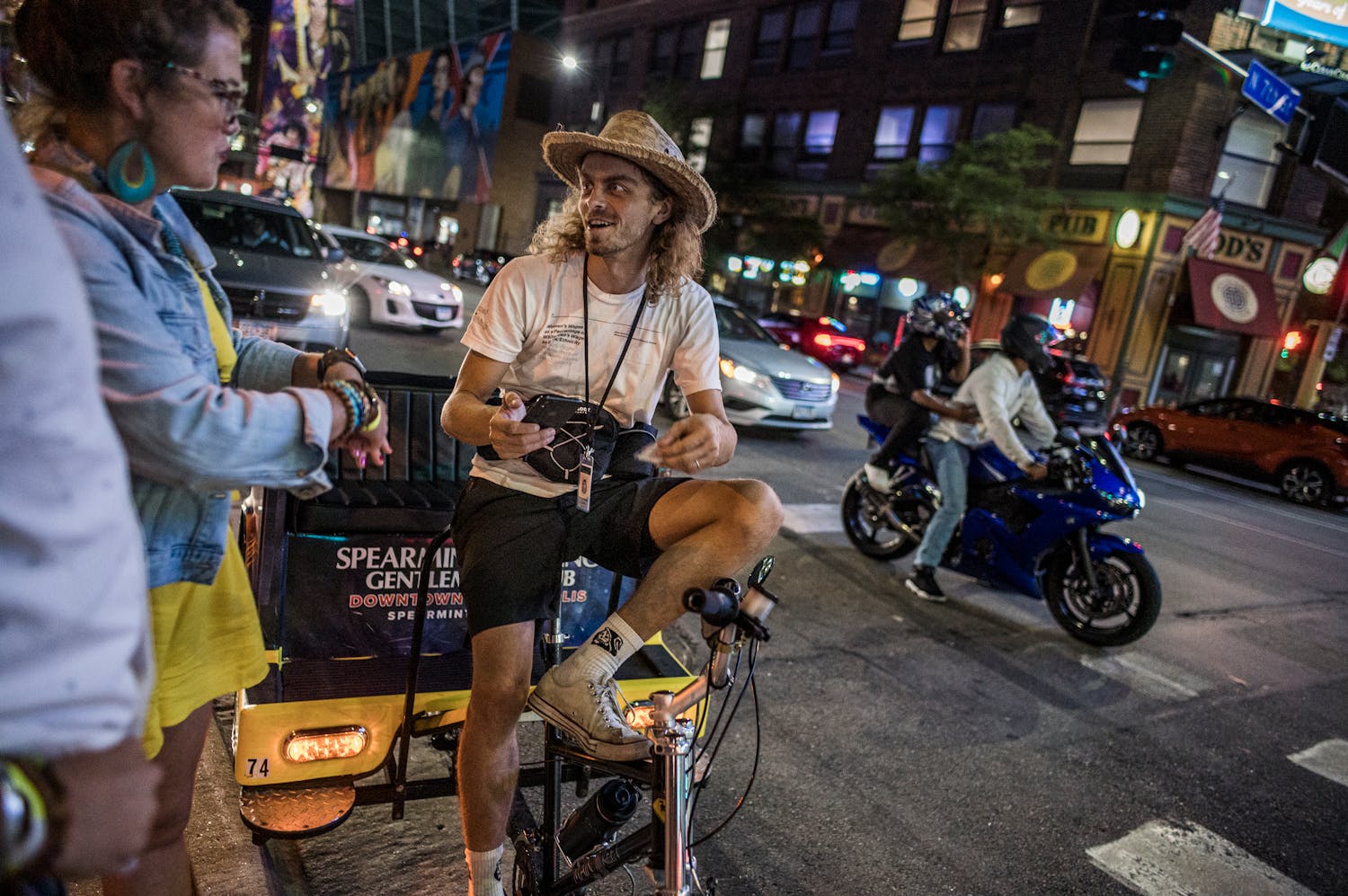As the sun set on E. Lake Street on a recent Saturday, a group of volunteers heaped clothes into garbage bags on a corner near Chicago Avenue.
Two years ago, the riots transformed this corner into a vacant lot, but today it bustled with this local ministry's yard sale, raising scholarship money for Black and Latino students. "It is a lot of stuff," said Columba Reyes, one of the volunteers, as she packed up for the night.
Motorcycles and drag-racers snarled down the street. A child grew tired of blowing bubbles and tossed his bubble wand high in the air to see if he could catch it. A passing motorist whooped out the open window.
The neighborhood looks more alive this summer than it did during the pandemic's dark days, but it may never return to what it was before. E. Lake Street is also home to the Third Precinct. Ruins of the police station still sit empty down the street, and many of the dozens of businesses torched during the riots have not recovered.
"Lake Street isn't what it used to be," said Gregorio Rivera, a volunteer for the charity sale.
The people of Minneapolis are living through strange times.
It's been two years, five months and 22 days since the Department of Health reported the first official case of COVID-19 in Minnesota. Three months later, after the murder of George Floyd, Minneapolis became the focal point of America's debate over the future of policing.
This summer, as Minneapolis mounts its comeback to a new version of normal, shootings and homicides are hovering above pre-2020 averages, the virus is still mutating and opioid addiction is surging in the background. At the same time, the lakes, patios and street festivals are booming with a surplus of appreciation accrued during months of lockdowns. Those scenes look nothing like a New York Times' columnist's casting of contemporary Minneapolis as a "dystopian ghost city" or a Fox News anchor's anarchist hotbed.
On this Saturday, a dozen Star Tribune reporters and five photographers set out to document a summer night in Minneapolis. They observed life from an emergency room, a homeless encampment, inside fire rigs and police squads and outside downtown bars as they closed. They found couples dancing in alleys and embracing on trains, kids goofing in parks and crowds swarming into busy stadiums and nightclubs. They saw blood on the street and people just trying to make it through the night.
The weekend brought 59 gunfire reports — accounting for four shooting victims — which is double the numbers from the same weekend in 2019. Journalists followed emergency responders who ping-ponged around the city on calls of violent crime, while others spent the bulk of Saturday night and Sunday morning on what could be called "drunk crime." The 10-hour period revealed a city in transition, teeming with activity and moments of pain, laughter, belligerence, mundanity, weakness and resilience.
Part I: Evening

Kennedi Mangun got a little closer to the basket with some help from Marice Gill, 16, at North Commons Park. Photo by Mark Vancleave, Star Tribune.
In North Commons Park, a group of young boys shout and laugh as they shoot free throws and scrap for rebounds. A few teenagers watch from the bench, or look on while riding bikes in tight circles on the edge of the court, itching to correct the younger ones' bad form.
"You did not deserve that point!" one of the boys calls out when another sinks a lucky shot.
Five miles south, the sun descends toward the horizon over Bde Maka Ska, and walkers and runners embracing the warm evening along the east shore offer an earful for eavesdroppers:
"They're going to give her a bone density scan ..."
"I don't care where I move ..."
"Quack, quack," squawks a slow-moving biker, shooing waddling ducks off the path.
In downtown Minneapolis, it's an hour before kickoff. Katelyn and Tricia Kell are conspicuous in the light-rail station outside U.S. Bank Stadium as among the only ones not wearing Vikings purple. "I should have worn my Packers jersey," muses Katelyn Kell, in town for the weekend with her aunt.
The pandemic crushed public transit ridership, but this summer it's starting to rebound. Some fear the accompanying violent crime on the trains has made them less safe than before. Asked if the reports worry them, the Kells shrug.
"I'm from Milwaukee," says Katelyn, who works as a bartender. "I know what to do."
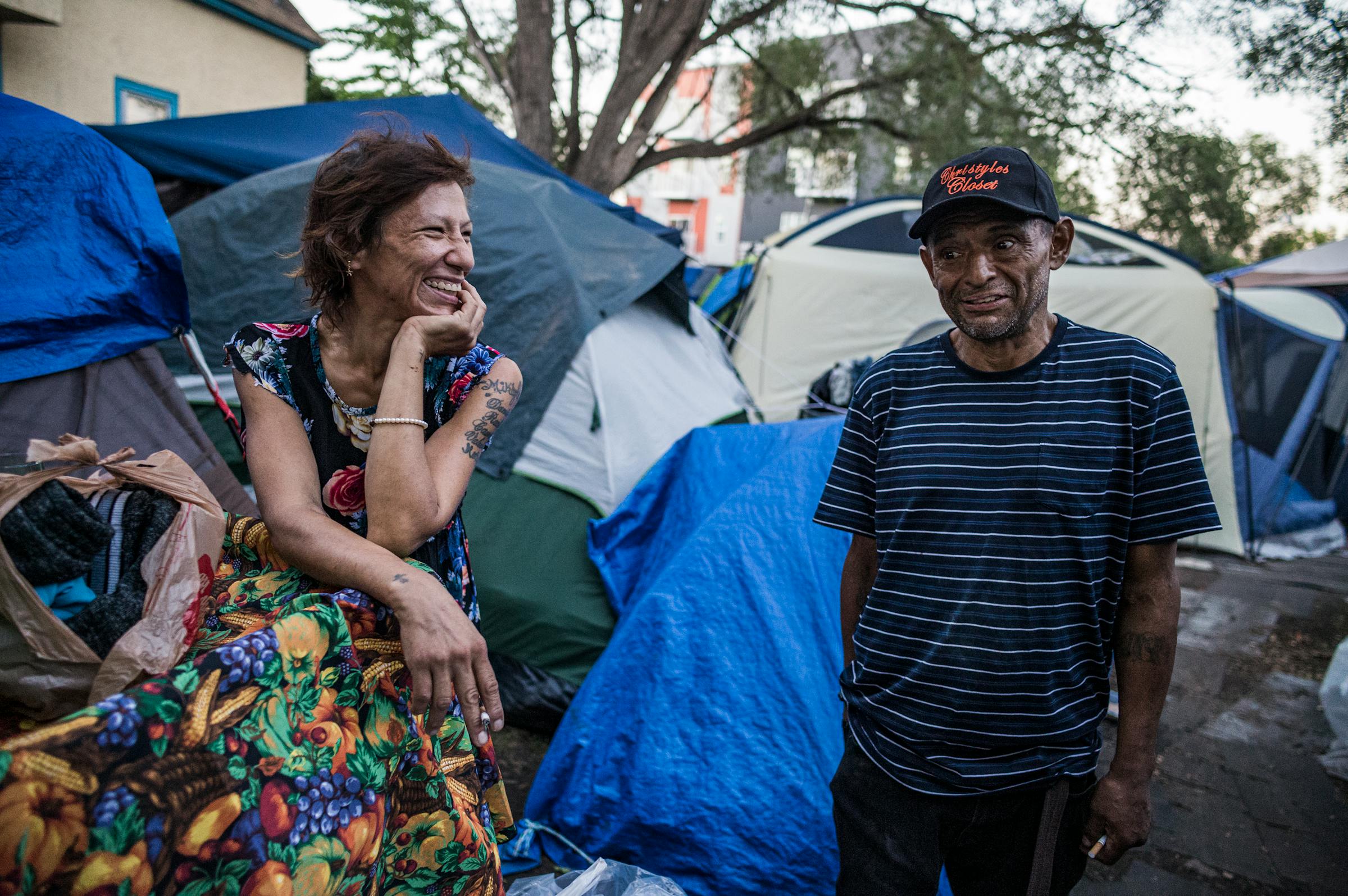
"We love fentanyl more than each other," said partners Tanya Jack and Moe Williams. Jack uses it to overcome trauma while Williams said it is for his severe arthritis. They are staying in a homeless camp in the Phillips neighborhood. Photo by Richard Tsong-Taatarii, Star Tribune.
Tanya Jack grins widely as she inspects herself from every angle, twisting her body around a spacious tent tucked near the edge of a crowded homeless camp in Minneapolis' Phillips neighborhood.
Jack likes what she sees. The bright, sleeveless dress she found at a thrift store days earlier drapes perfectly over her slight frame, and the navy blue matches the color of the tattoos of her six children's names on her left shoulder. "I feel beautiful," says the 45-year-old member of Wisconsin's Lac du Flambeau band as she steps into the warm evening air. "Who says that just because I live in a homeless camp that I can't feel beautiful — at least for a while?"
It's been a difficult past 20 hours for Jack.
Around 1 that morning, she and her partner, Moe Williams, were startled awake by the sound of gunshots fired right outside her tent, and a strange man yelling at everyone to shut off their lights. The shots were so close that Jack thought she could hear the sound of a bullet hitting a nearby fence.
Jack is reluctant to leave the patch of soil that is her home. Staying put means she will be assured a supply of fentanyl, the deadly synthetic opioid that she and her partner smoke or inject several times a day. Out here, Jack does not have to venture far to find the drug. The users and dealers live side by side in tents in the camp. Some occupants refer to the site as "Camp Feti," slang for fentanyl.
"Everything is beautiful on fentanyl," says Jack, who has been homeless off and on for eight years. "There's no worrying about not having enough money to live. There's no physical pain, no mental pain. It's my medicine."
Later that night, Jack takes her final dose of fentanyl for the day in her tent as her partner watches to make sure she doesn't overdose. Then she drifts off to sleep with her shoes on.
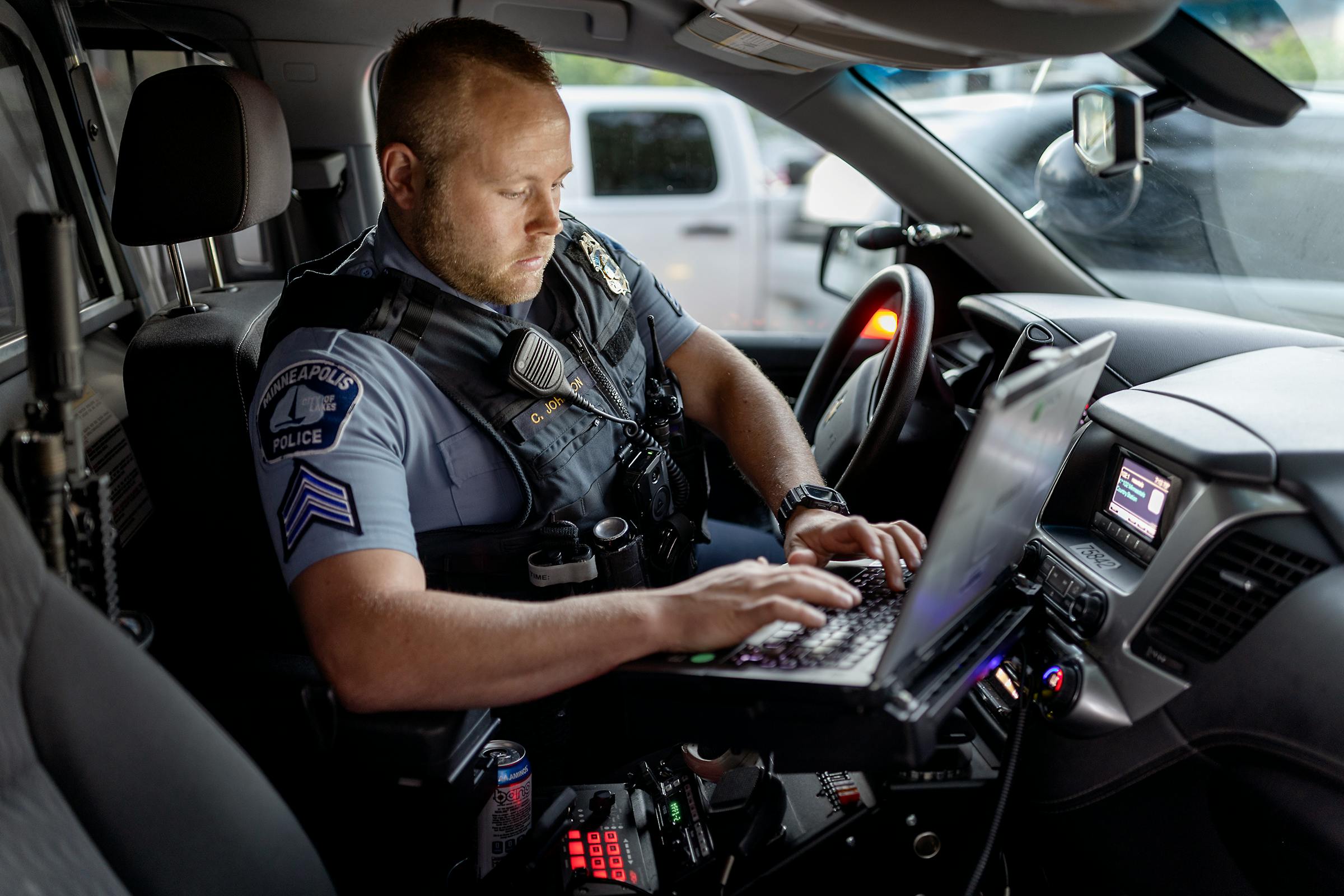
Sgt. Cody Johnson typed in a call he answered. Photo by Elizabeth Flores, Star Tribune.
Loud domestic, possibly physical ...
The radio squawks, cutting through an upbeat country song bellowing out of Minneapolis police Sgt. Cody Johnson's dashboard.
It's three hours into the middle-watch shift in the Fourth Precinct, a wide swath of north Minneapolis containing some of the city's most historically disenfranchised neighborhoods and highest concentration of gun violence. Tonight, Johnson is among nine officers on patrol for the whole area, down from 12 or 14 a few years ago.
Still, it's the only precinct the eight-year veteran officer has ever wanted to work. "It's where the action is," Johnson says.
He rolls up to the corner of N. Plymouth and Vincent avenues, where two of his colleagues are attempting to calm a distressed woman. She's come to confront the man who she says stole her Apple Watch. The guy tells the officers she gave the watch to him as a birthday present, and he intends to keep it.
Once he retreats inside, she marches straight to the apartment complex intercom, jamming her finger on the button to repeatedly scream: "Give me my watch! Give me my watch!"
Next door, a woman monitors the situation as she braids her daughter's hair on the front stoop, and three youngsters playfully chase their dog in the yard. A man on a scooter across the street stops to survey the chaotic encounter. The night is just getting started.
Most evenings this summer, a group of mostly Somali men gather at Bryant Square Park, near Lyn-Lake, to play pickup soccer.
Tonight there's a game on each ballfield. One for longtime players and the other for newer, younger ones, explains Ali Jama, a de facto captain. "It's a little bit of African style," he says of the sandy, low-friction surface that resembles what many players grew up kicking on.
"We come to have some fun, get some sweats," Jama says. A couple of young girls in bright-colored hijabs run onto the edge of the field before spectators wave them back to the playground.
Downtown, a group of 12 revelers, resplendent in their purple garb, board a Blue Line train and begin snapping selfies. A woman in the group attempts to do chin-ups using the train's luggage rack, as her friends egg her on.
"What stop do we get off of?"
"I'll know it when I see Sneaky Pete's," replies one of her companions, referring to the nightclub. They file off at the Warehouse District station and noisily disappear in the direction of the downtown bar and club scene.
Part II: Dusk
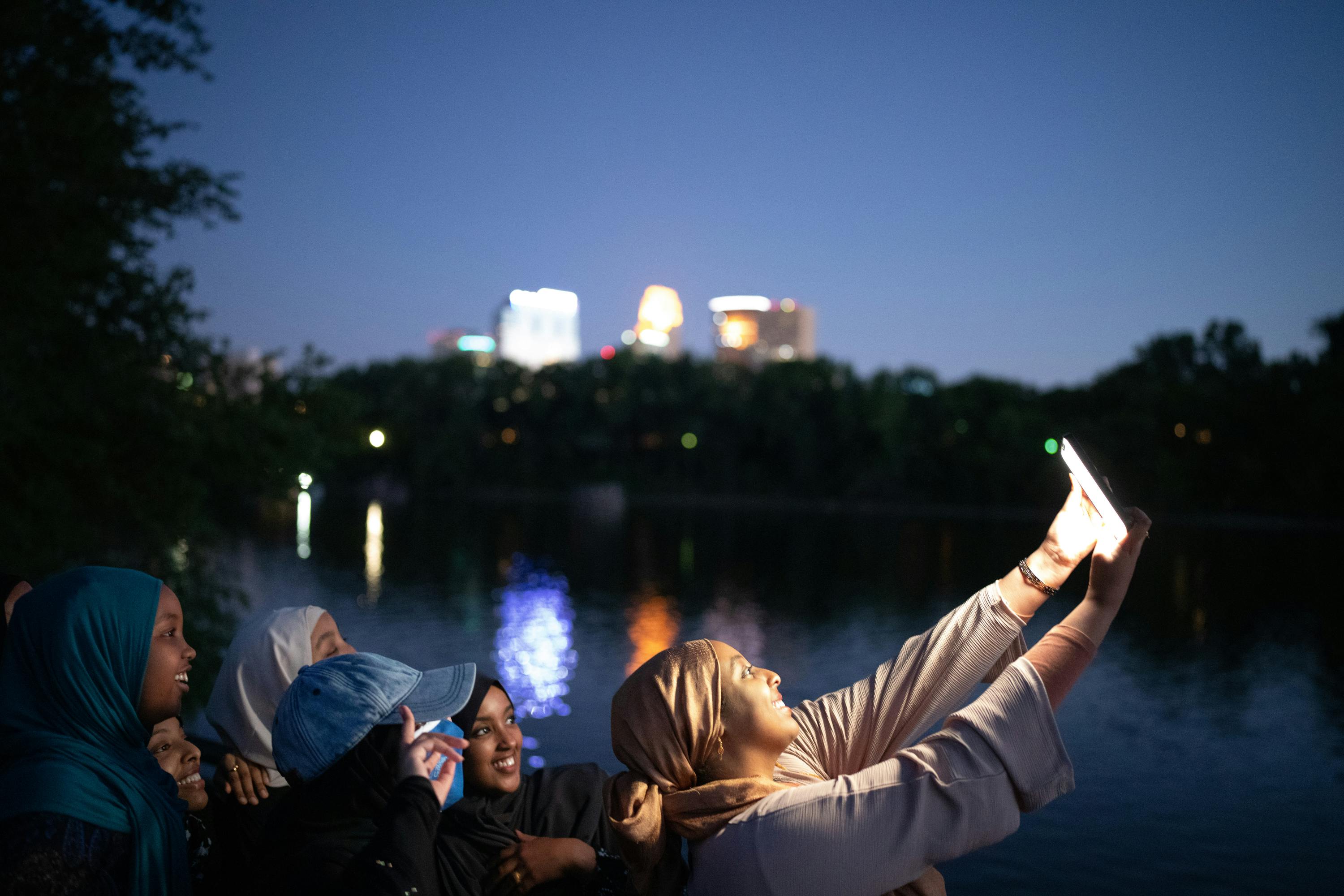
Naema Ali and her cousins posed for a selfie after a family picnic at Boom Island Park. Photo by Mark Vancleave, Star Tribune.
Engine 19, difficulty breathing report on Malcolm Avenue …
Overdose on Park Avenue downtown …
A male in a restroom having an asthma attack …
Capt. Jeremy Norton is sitting in a beige office, a pair of bright-green glasses perched on his nose, catching up on paperwork as the 911 dispatcher drones in the background. In other rooms of Station 17, firefighters are watching TV or resting up in one of the bedrooms as they head into the last leg of a 48-hour shift.
It's been a slow night for Norton's crew, but peace is fragile in their business. They went all summer without responding to a gunshot victim, then a couple of weeks ago they caught a double shooting at 38th Street and Chicago Avenue in broad daylight outside a Sunday church service.
Norton came to that same intersection 2½ years ago on a report of a man with a bloody mouth. He arrived seconds after paramedics had taken an unresponsive George Floyd to HCMC, and Norton has testified in two trials of the officers. One call can change everything.
"Engine 5 for an overdose on Second Avenue S.," announces the disembodied voice of the dispatcher.
Some emergency responders won't go to the area now called George Floyd Square without a police escort out of fear for their own safety. Norton isn't one of them. The area has long been home to some problematic individuals, but the perception of the square as the center of a lawless underworld is "preposterously wrong." He respects what the community has tried to do with the square, to make it a healing place. "I personally feel the city missed a lot of opportunities to turn it into something positive for the community," Norton says, like creating a racial justice memorial.
"Eight-month-old child is struggling to breathe …," announces the dispatcher later.
This time, the lights in the station blink overhead and an alarm rings, signaling Norton's crew is up.
Steve Mudek, who joined the department eight years ago, jolts awake from his room and moves mechanically toward the station garage as he throws on his gear.
In seconds, Engine 17 is coming alive on the dark streets.

Firefighter Steve Mudek put on his equipment after a medical call came through at Fire Station 17. Photo by Alex Kormann, Star Tribune.
The night passes with small dramas, comedies and a few tragedies unfolding across the city.
In Powderhorn Park, music blares as 14-year-old Jesse Vilchiztrejo and his 8-year-old sister Jhoanna break open a pinata and ride a mechanical bull. Guests for their joint birthday party wear cowboy hats, sip Modelo and eat plates full of home-cooked carnitas. In the alley, a young couple presses together, dancing a Latin step. Jesse, feeling emboldened from having earned his black belt in taekwondo that morning, rides the bull one-handed and tosses his hat into the crowd.
In Dinkytown, a dozen people gather on the corner of 14th Avenue and 4th Street, outside a new Korean hot dog joint, and wait for their food as nightfall cools the air. Por Choua Yang, Kevin Nguyen and Carl Johnson, all 18, are visiting from western Wisconsin and all three will start college soon. A car races by and the noisy rev of the engine cuts off all conversations.
At HCMC's trauma center, health care assistant Becca Wangen finishes with one patient when the arrival of another is announced. She slumps against the wall, clutching her head, before rushing back inside the stabilization room.
"I'm by myself because we're short-staffed," she says.

HCMC Emergency Department health care assistants Becca Wangen, left, and Jodi Lieder worked quickly to clean and prepare a new bed for a critical patient en route to the hospital. Photo by Aaron Lavinsky, Star Tribune.
A young man smoking a cigarette boards the eastbound Green Line train. "Do you need some weed?" he asks. A man and a woman, both in Twins garb, awkwardly lean into each other with their mouths wide open, attempting to kiss, but mostly missing the mark.
In north Minneapolis, 26-year-old Jahliah Holloman approaches a group of people gathered outside of Merwin Liquors, some of whom are armed. Holloman is with Restoration Inc., an organization of violence interrupters who partner with Minneapolis' Office of Violence Prevention, and she spends the evening out in the community talking to neighbors.
"We're not here to police or take away anyone's freedom," Holloman says. "We're here to break down what's been breaking the culture."
Per and Becca Andreassen sit by the fire in the yard of their North Side home as a friend strums a guitar and sings. The couple moved to the Twin Cities last year from East Grand Forks, Minn., and their yard is lush with trees, plants and a garden containing chickens in pens. A few people gather to listen to the music, while children run around the garden with s'mores and water cups. While there may be economic violence and gang violence in the neighborhood and beyond, it's why idyllic nights like these feel even more important.
"What can you do? Plant a garden. Invite your musician friends over," Per says.
Back at Chicago Avenue near Lake Street, the yard sale volunteers have finished packing up and gone. A very different crowd is gathering around the corner near the Midtown Global Market. They get high. A man staggers around the street yelling.
"I got a place to stay, but I'm still addicted to the streets," says a 67-year-old man who only identifies himself as Memphis. A woman approaches and hands him a bottle of peach brandy. "When it gets dark, that's the only time I come out, but ain't nobody out here except police and crooks."
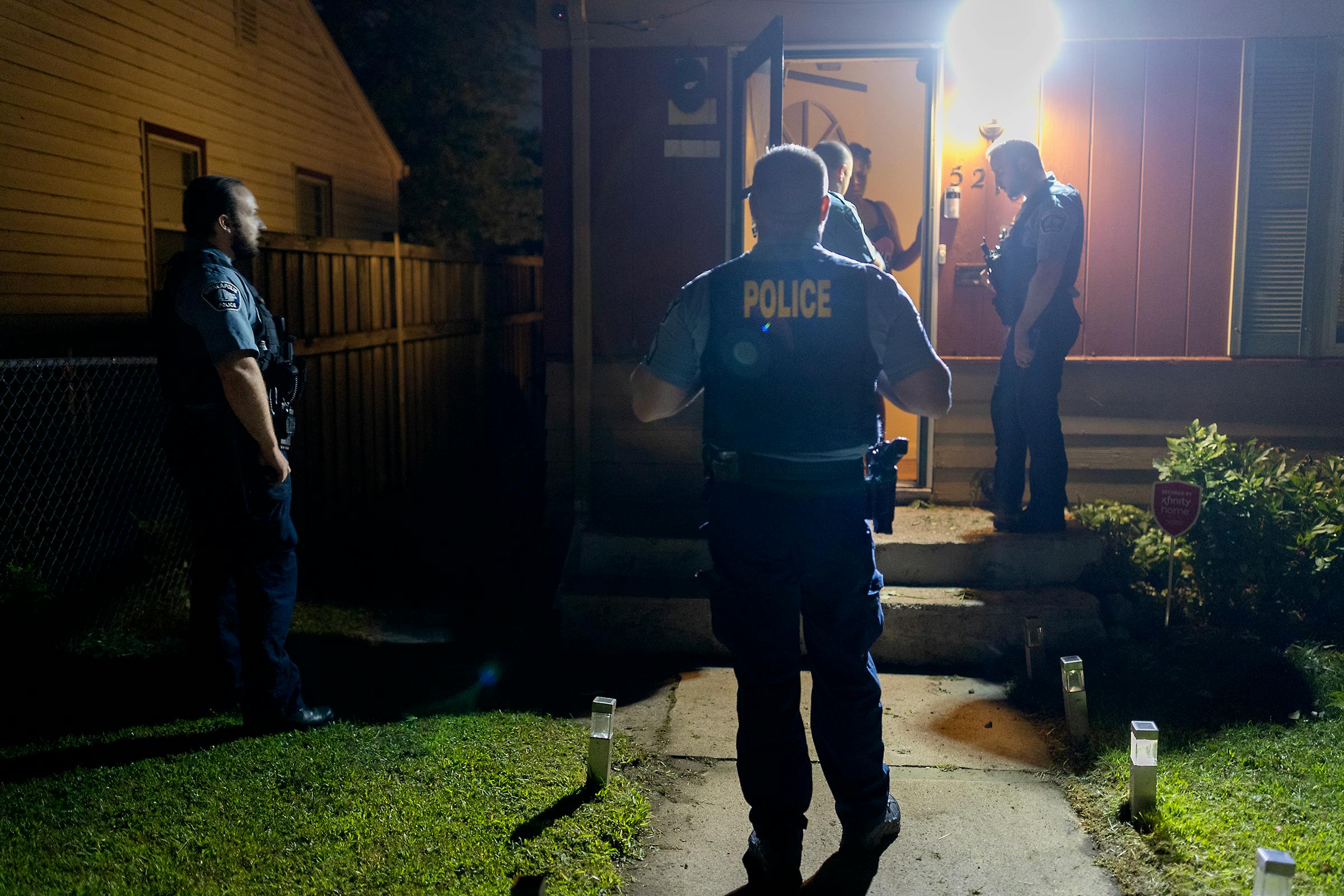
Sgt. Cody Johnson, center, watched as officers from the Fourth Precinct responded to a domestic dispute call. Photo by Elizabeth Flores, Star Tribune.
Johnson cruises to a call from two young girls who say a red car is following them. He finds the frightened 12-year-olds on N. 47th and Colfax avenues. They scurry into the squad with a story about some older boys chasing them from a birthday party in a North Side park. Johnson escorts them home to a grateful father.
Johnson's laptop chirps again and the blue glow of the screen illuminates his face.
"Caller has an injury to his face," he says. The report indicates a man was assaulted with a coffee pot. It's the second domestic-related call of this shift. Johnson arrives at the house, near the border with Brooklyn Center, where four other officers have parked.
They find no injured man; only blood and shattered glass on the floor of the kitchen.
"What happened?" an officer asks the female homeowner. "Where is [the victim]?"
"Ya'll are just some Trump supporters," she responds.
"Who is [he] to you, anyway?" the officer presses, ignoring the comment.
"I remember what happened to George Floyd!" she exclaims.
A few blocks away, they find the man sitting in an ambulance with a blood pressure monitor coiled around his arm, pressing a wad of gauze to his cut lip.
Two months earlier, Johnson recalls, police responded to the same location following a drunken argument. That time, though, they arrested the man for stabbing the woman with a pair of scissors.
"Eventually it's going to end up worse," Johnson sighs.
Soon after, he's dispatched to an alley in the Hawthorne neighborhood for a report of shots fired.
Johnson inches slowly down the backstreet, toggling a bright flashlight affixed to the driver's side window to scour for shell casings. The alley appears deserted. No shooter, no victim.

Bride-to-be Heidi Schulz celebrated her bachelorette party at the Gay 90's. Photo by Richard Tsong-Taatarii, Star Tribune.
Outside the 7th Street and Hennepin Avenue bus stop, a young girl on a scooter crashes into a garbage can before quickly picking herself up and zooming away.
After a long day of bar hopping for her bachelorette party, bride-to-be Heidi Schulz, 24, of Grand Forks, N.D., is ready to rest. She kicked off the day with a drag brunch and ended it among a throng of fellow bridal parties at the Gay 90's. "We have drag shows in Grand Forks but nothing like this," she says.




